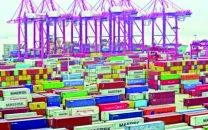Economy performing better than expected: ministry
Industrial sector lags behind as big manufacturers encounter challenges

The government said on Wednesday that Pakistan's economic performance during the current fiscal year remained better than expectations and inflation is expected to further recede to around 6% in November.
In its monthly inflation outlook, the Ministry of Finance, however, cautioned that the industrial sector was not performing well with large-scale manufacturing (LSM) facing "challenges". The report was prepared by the economic advisory wing of the ministry.
Inflation is expected to remain within the range of 5.8% to 6.8% in November and further recede to a range of 5.6% to 6.5% by December, the report said.
Inflation assessment for December had been made before the disruption of supplies due to the federal government's decision to close motorways and highways for four days. The resumption will be slow, which may impact prices in the first 10 days of next month, according to market analysts.
Major factors behind the slowing inflation include a high base effect and better supplies of food items. Last month, inflation stood at 7.2% due to a significant slowdown in inflation rates for perishable food items, housing, water, electricity, gas and fuels, according to the finance ministry.
The central bank has cut its policy rate by 2.5 percentage points to 15% this month due to faster-than-expected decline in inflation, which reached its medium-term target range in October.
Besides the tight monetary policy impact, a sharp decline in food inflation, favourable global oil prices and maintaining gas tariffs with low petroleum levy rates have eased inflationary pressures in recent months, according to the report. It added that in coming months, fiscal consolidation and contained inflation would provide impetus to economic activities.
Pakistan's economy is exhibiting sustained recovery in the ongoing fiscal year. First four months have shown better-than-expected improvement, marked by receding inflation, a significant increase in remittances and IT exports, sustained external and fiscal sectors and a downward trend in interest rate, said the ministry. Recovery across all sectors would support the achievement of targeted economic outlook in coming quarters, it added.
For the current fiscal year, the economic growth target has been set at 3.6% while inflation target is 12%. Political instability coupled with economic policies being implemented under the International Monetary Fund (IMF) package will slow down the economic wheel.
The finance ministry stated that LSM-related indicators highlighted "a sector striving to recover". It added that annual LSM growth remained negative but monthly performance showed signs of resilience, with gradual production increases in key sectors such as textile and automobile.
It said that the real sector of the economy continued to get support from agricultural and industrial policies. On the agricultural front, wheat crop sowing is in progress to achieve the targeted area and production. Government facilitations are well intact regarding timely provision of key inputs to farmers at reasonable prices.
The federal government has urged provinces to make efforts to ensure input supplies and facilitate farmers to enhance wheat sowing. "Input situation is encouraging," said the ministry.
The finance ministry said that imports of agricultural machinery increased 70.9% to $39.6 million. During Rabi 2024-25 season (October 2024), di-ammonium phosphate (DAP) offtake significantly increased by 92% while urea offtake decreased by 22% compared to the same period of last year.
The surge in DAP offtake is attributed to the disbursement of interest-free loans to small farmers by the Punjab government for the purchase of inputs such as seeds and fertilisers, it added.
The LSM slowdown is hurting the Federal Board of Revenue's tax receipts in addition to its weak enforcement measures. The finance ministry said that exports, imports and workers' remittances would continue to show increasing trend, predicting that exports would remain within a range of $2.5 billion to $3 billion.
Imports may stay in the range of $4.5 billion to $4.9 billion and remittances could range from $2.8 billion to $3.3 billion in November. There is an element of consistency in exports and remittances that has provided a sigh of relief to the government, which is still struggling to secure planned loans despite the IMF deal. The external account position improved on account of notable increase in exports and remittances notwithstanding the increase in imports. During Jul-Oct FY25, the current account recorded a surplus of $218 million compared to a deficit last year.


















COMMENTS
Comments are moderated and generally will be posted if they are on-topic and not abusive.
For more information, please see our Comments FAQ